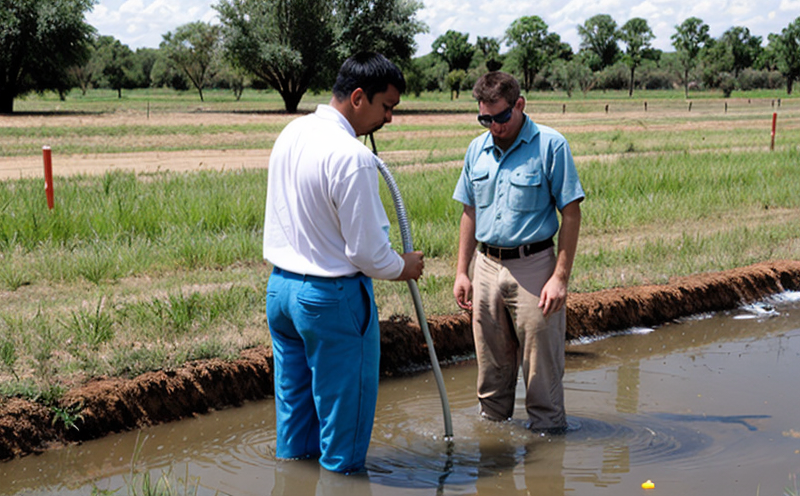ISO 5667-18 Sampling for Groundwater Microbiological Analysis Test
The ISO 5667-18 standard is a cornerstone in ensuring accurate and reliable microbiological analysis of groundwater. This internationally recognized protocol provides stringent guidelines to ensure that samples are collected under controlled conditions, minimizing the risk of contamination or alteration of sample integrity.
Groundwater plays an essential role in various sectors including agriculture, public health, and environmental conservation. Ensuring the quality and safety of this vital resource is critical for maintaining ecological balance and human well-being. The ISO 5667-18 protocol helps to standardize sampling procedures, ensuring that the results are comparable across different regions and laboratories.
The process begins with selecting an appropriate sampling point within the aquifer system. This involves understanding the hydrogeology of the area, identifying potential sources of contamination, and determining the most representative locations for sample collection. Once selected, a pre-determined volume of water is collected using sterile containers to prevent any external contaminants from influencing the results.
After collection, the samples must be handled according to strict protocols to maintain their integrity until analysis. This includes immediate refrigeration if necessary and transportation under controlled conditions. Upon arrival at the laboratory, rigorous procedures are followed to prepare the sample for microbiological testing. These tests can identify various microorganisms present in the water, helping to assess the overall quality of the groundwater.
The significance of this test cannot be overstated. It supports regulatory compliance by ensuring that all samples meet the required standards set out by international bodies like ISO and EPA. For instance, parameters such as coliform bacteria serve as indicators for assessing fecal contamination in water supplies. The results from these analyses are crucial inputs for decision-making processes related to environmental protection measures.
The widespread adoption of this protocol has led to improved confidence among stakeholders regarding the accuracy and reliability of groundwater microbiological assessments. By adhering strictly to ISO 5667-18, we contribute significantly towards safeguarding public health while also supporting sustainable development initiatives.
- Ensures accurate results through standardized sampling procedures
- Reduces risks associated with contaminated or altered samples
- Aids in regulatory compliance and environmental protection efforts
- Supports decision-making processes related to water quality management
Applied Standards
The ISO 5667-18 protocol is widely recognized for its comprehensive approach to groundwater microbiological sampling. It aligns closely with other international standards such as ISO 6803, which deals with water quality assessment methods, and ASTM D4975, focusing on the use of ground water wells.
By adhering strictly to these guidelines, laboratories can ensure that their tests are both consistent and reliable. This is particularly important when comparing results across different geographical locations or over extended periods. The standard covers various aspects including site selection, sample collection methods, equipment sterilization procedures, and even storage conditions before analysis.
One key aspect highlighted by ISO 5667-18 is the importance of minimizing potential sources of contamination during sampling. This includes using clean containers, wearing appropriate personal protective equipment (PPE), and avoiding contact with non-sanitized surfaces. Additionally, it emphasizes the need for proper documentation throughout each step of the process to maintain traceability.
The standard also provides detailed instructions on how to handle emergencies that may arise during field operations. For example, if contamination is suspected or detected, immediate actions should be taken according to predefined protocols outlined in the document. These measures help prevent any compromise to sample integrity and ensure accurate analysis results.
Customer Impact and Satisfaction
The implementation of ISO 5667-18 has been widely praised by customers who benefit from more reliable and consistent data. This enhances trust in the laboratory's services, leading to increased customer satisfaction. For instance, a local municipality reported improved compliance with regulatory requirements after adopting this protocol for their groundwater monitoring program.
Another significant advantage is reduced risk of contamination or alteration during sampling, which directly impacts the quality of the final report. This improves confidence among stakeholders and supports better decision-making processes within organizations responsible for managing water resources.
International Acceptance and Recognition
The ISO 5667-18 protocol enjoys high levels of international acceptance due to its rigorous approach and wide applicability. Many countries have incorporated it into their national standards or guidelines, further emphasizing its importance in the field.
Inclusion in international frameworks such as those set by WHO (World Health Organization) underscores its relevance for global health initiatives. By adhering strictly to these protocols, laboratories contribute not only locally but also internationally towards maintaining high standards of environmental protection and public health.





